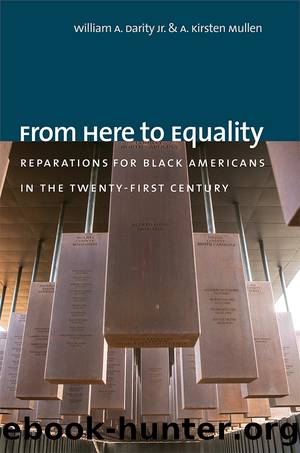From Here to Equality by William A. Darity & A. Kirsten Mullen

Author:William A. Darity & A. Kirsten Mullen
Language: eng
Format: epub
Publisher: The University of North Carolina Press
Published: 2020-03-15T00:00:00+00:00
Anthony Foxx, the secretary of transportation during the second term of the Obama administration, grew up in Charlotte, North Carolina, where he also served as mayor. There, the black community known as Brooklyn was âevisceratedâ by the interstate highway system; today, Brooklyn no longer exists.19 Foxx estimates that throughout the United States during the first twenty years of installation of the interstate highway system, 475,000 families and more than a million citizens were displaced. These, overwhelmingly, were residents of black communities.20
In some cities, municipal authorities bore the responsibility for introducing new roadways that performed the same functionâgetting rid of âthe local niggertown.â For example, in Durham, North Carolina, the flourishing black business district, Hayti, was erased by two major road construction projects. First, in the late 1950s, the Durham Redevelopment Commission conceived and executed a plan to run an east-west expressway (US 15-501) through the center of the area. Still active in the 1960s, the commission planned a second thoroughfare, the Durham Freeway (NC 147), which crossed the expressway, displacing even more black enterprise and destroying Hayti.21
While urban renewal constituted a process of âNegro removalâ engineered by the public sector, gentrification constitutes a process of âNegro removalâ engineered by the private sector, frequently with public sector support. Gentrification principally involves the displacement of low- and moderate-income blacks by affluent whites from neighborhoods where blacks have lived for generations.
In many instances, whites are âreclaimingâ Americaâs inner cities. This process frequently is coupled with the demolition of the high-rise public-housing buildings that were built after the leveling of black-owned single-detached homes, the substitution of public and low-income housing with âmixed-incomeâ housing, and the continued designation of predominantly black communities as areas that require economic renewal and development. In short, the black population literally is pushed out of their homes and neighborhoods.
Dallas, Texas, provides a paradigmatic example of the reversal of the original âurban redevelopmentâ project, a reversal that now promotes the comprehensive whitening of once all-black communities. The âA New Dallasâ plan proposes to tear down the highway that once was built through the heart of a black business district to reopen the land to commercial and residential use, but it promises to bring a very different population into the area than the one that had developed a community there in the past.22
Another BrooklynâBrooklyn, New Yorkâprovides a dramatic example of the various dimensions of the private-public collaboration that makes gentrification happen. Between 2000 and 2010 it is estimated that Brooklyn lost 50,000 black residents, while its white population increased by 37,000. Blacks faced with foreclosure and/or job loss during the Great Recession were enticed into turning over their deeds to white developers and surrendering their rent-controlled apartments for comparatively small sums of money.
The dilution of rent regulation in New York City also has contributed to the push-out effect; an empty apartment no longer is subject to rent control. Once a rent-controlled apartment is vacated, the landlord is free to increase the rent. Moreover, an apartment is no longer subject to rent regulation
Download
This site does not store any files on its server. We only index and link to content provided by other sites. Please contact the content providers to delete copyright contents if any and email us, we'll remove relevant links or contents immediately.
Pale Blue Dot by Carl Sagan(3997)
The Rules Do Not Apply by Ariel Levy(3898)
Goodbye Paradise(2950)
Delivering Happiness by Tony Hsieh(2919)
Liar's Poker by Michael Lewis(2806)
Into Thin Air by Jon Krakauer(2695)
Purple Cow by Seth Godin(2695)
Ogilvy on Advertising by David Ogilvy(2678)
Rogue Trader by Leeson Nick(2469)
The Airbnb Story by Leigh Gallagher(2364)
The Social Psychology of Inequality by Unknown(2305)
The Mind Map Book by Tony Buzan(2075)
Six Billion Shoppers by Porter Erisman(1996)
Bossypants by Tina Fey(1983)
Claridge's: The Cookbook by Nail Martyn & Erickson Meredith(1959)
All the President's Men by Carl Bernstein & Bob Woodward(1956)
Master of the Game by Sidney Sheldon(1877)
Alibaba by Duncan Clark(1752)
Wild Ride by Adam Lashinsky(1655)
